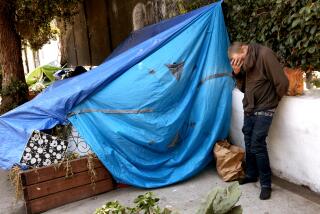REPORTER’S NOTEBOOK : Parting Shots in Duck Fight at Venice Canals
- Share via
VENICE — It was The War to End All Ducks.
By Wednesday, when state wildlife workers launched a victorious final offensive on its canals, Venice’s lore had grown by one more tale. The effort to eradicate the entire population of local ducks--believed to carry a deadly avian plague that threatened millions of migratory fowl--ignited a three-week uprising among duck lovers that split the pretty neighborhood, fed every manner of conspiracy theory and brought the national media galloping to yet another only-in-Venice spectacle.
Some scenes for the scrapbook:
*
It is just after dawn on Tuesday and mortgage banker Dennis Shwam is walking his dog along Linnie Canal. He is irritated, says the news media have ignored the canal residents who agree with the duck kill. He is sick of hearing duck backers described as “canal residents,” and says that too many of them are outside animal-rights activists who grabbed the microphones and the headlines.
Shwam likes the ducks all right, but thinks their fans have overfed them, crowding out wild birds who might settle there and create a real wildlife habitat.
The division over the ducks mirrors sharply differing visions of the gentrifying community, where bungalows have fallen to make room for big modern boxes and BMWs are as at home as the flyers offering a “spiritual vegetarian home.” Not everyone likes the big canal restoration project that has added sidewalks and concrete-block banks; some of the duck backers call it the “Newportization” of the once-funky neighborhood.
The plot-minded are sure the state Department of Fish and Game is in cahoots with developers. Today they take the ducks, one activist warns, tomorrow they pave the canals.
Shwam’s concerns are more immediate. He scuffs bird droppings off the sidewalk and grumbles that the duck-pollution problem is worse than ever: “All you get are feathers and poop.”
*
Starting at 5:30 a.m., duck supporters gather on the little arched bridges over the canals. Some will go off to work later; the hard-cores will stay all day, searching the horizon for vehicles with the enemy’s insignia. Their weapons are limited to an antique pump-action bullhorn and a police scanner they use to monitor the movements of Fish and Game officials.
It is an edgy, cat-and-mouse affair where each sighting of an agency vehicle is fresh evidence of spying. One woman urges the group to moon a warden who is checking the scene through binoculars. Some worry that they will get caught on TV.
Wildlife officials guard their moves, concerned that the media will draw protesters like ducks to tossed bread crumbs.
“It’s psychological warfare,” says duck supporter David Zucker, who wears the scanner on his belt. You have to be careful about the transmissions, he explains: The wildlife people have taken to sending messages intended to mislead the duck forces. But an intercepted call requesting more yellow police-scene tape sounds authentic--a capture is about to begin.
A scout returns from a reconnaissance “drive-around” and reports that a whole bunch of department trucks are parked on Grand Canal, south of Washington Boulevard. The group of duck supporters, numbering just half a dozen by midmorning, troops off to confront the enemy.
*
The duck people don’t get many chances to disrupt the wildlife workers, who do their job in wading boots and protective jackets, herding the docile birds into a pen before the ducks are moved elsewhere and killed by injection.
The protesters, prevented by police and game wardens from coming any closer than about 100 feet from the pens, have decided not to do anything that will get them thrown in jail. Instead, they blow whistles and make quacking noises to scare away the birds. During one capture, several of them take to driving back and forth along Grand Canal, horns blaring. The tactics fail. Two of the horn-blowers are ticketed.
During Wednesday’s roundup at the Venice Canals, a group lines one of the bridges, chanting “Fish and Game has no shame!” and “Killers! Killers!” as the workers herd the ducks toward a capture pen. A bare-chested man walks around letting out wobbly Tarzan cries while eight protesters duck into a garage in a game of grown-up hide-and-seek from authorities.
“This reminds me of when I was in high school. I used to do (uh, stuff) like this,” giggles group leader Bill Dyer, a Big-Mac-eating-lyricist-turned-animal- rights-vegetarian. Moments later, the group springs out, shouting and banging on a wall near the capture pen. A few startled ducks fly away from the pen, but most swim on into it.
*
The duck kills hit the Hall family especially hard. All nine of their store-bought Rouen ducks are rounded up near the family’s home on Grand Canal along with the mallards and hybrids that make up most of the local duck population.
Deborah Hall and her 6-year-old daughter Maggie peer into the cages on a Fish and Game truck, picking out their lighter-colored pet ducks and explaining desperately to wardens that it is all a big mistake. She even has a receipt from the pet store where they bought the ducks a month ago. To no avail. The ducks are carted off with the others.
Two days later, 10-year-old Niko Hall is still mad at the wardens. “I wanted to kick them,” he says.
*
By the end, both sides are war-weary. After days of dawn vigils and a heartbreaking defeat, weeping protesters comfort each other and plan their first good night’s sleep in weeks.
“It’s definitely going to be quiet,” says canal resident Yolande Michaels, a psychologist who was one of the campaign’s leaders. “I feel like an era has concluded. It feels like there may never be ducks again.” But she and others promise to carry on the fight by challenging wildlife policies that call for eradication of animals that are believed to carry such diseases.
A few feet away, Fish and Game workers--who came out of the woods all over California to help--are glad their turbulent Venice visit is ending. A spokesman acknowledges that the agency could have prevented problems by meeting with more residents beforehand.
“It’s been expensive. It’s been heart-wrenching. It’s not what we’re in the business to do,” says spokesman Patrick Moore.
As workers load the caged ducks, agency veterinarian Pam Swift glares over at the crowd that has been pelting her with taunts and insults.
“Anytime you have an operation like this in suburbia, you’re going to have trouble,” she says. “This is wildlife to them. This is it.”
*
By late afternoon Wednesday, the duck group’s headquarters--a grassy lot next to Linnie Canal--is empty except for fluttering get-out-the-troops flyers and funeral flowers devoted to “our dear loved ones who went to duck, geese etc. heaven. We loved you.” Gone is the posted duck poem as well as the cooked duck carcasses that someone had impaled on nearby fence posts as a joke or threat last weekend.
By the end of the roundup, someone has added one more melodramatic touch to the bulletin board--an upside-down American flag with writing on it. “America is dead,” it says.
Nearby, a neighbor hoses duck droppings from her sidewalk.
More to Read
Sign up for Essential California
The most important California stories and recommendations in your inbox every morning.
You may occasionally receive promotional content from the Los Angeles Times.










